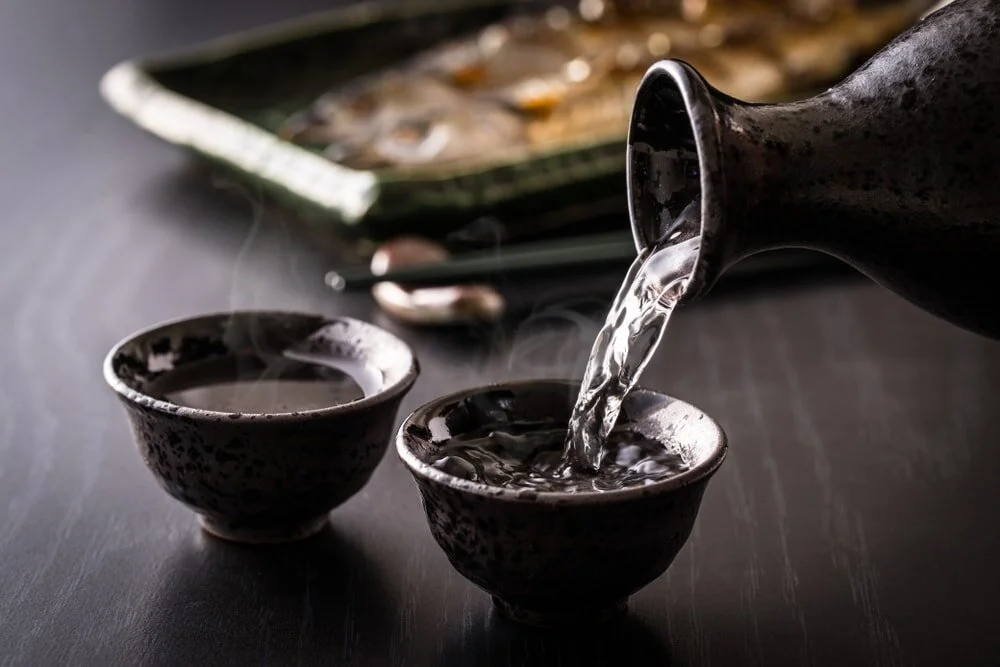What are the differences between sakes?
Today we're going to talk about the four main styles of sake: Junmai, Honjozo, Ginjo and Daiginjo. We'll also briefly touch on some of the other styles you might see out there. Before we dive into each individual sake and their unique profiles, I want to touch on sake basics.
So right off the top, what is sake? A great misconception is that sake is hard alcohol, it's distilled. In fact, it's brewed, so it's more similar to wine and beer. Sake does have a higher alcohol percentage than wine, sits about 15%, but honestly, it can range from 12% all the way up to 20%. Sake also is naturally sulfite free and usually gluten-free, so it makes it a great choice for guests that have allergies. So unlike wine, sake is not classified by its varietals, but instead by its polishing. When you polish the grain you get to the heart of the rice, and that's where you find all the flavours and aromatics. The more layers removed before brewing, the purer and more refined the flavour.
Alternatively, the less that it removes, it's going to give you a bigger, more robust flavour. Now I'm sure you've heard or seen people talk about sake being warmed or chilled. You're wondering why and what kinds of sake can do that? Don't worry, we'll talk about that later.
Up first, Junmai.
The first sake we're going to talk about is Junmai, and while it's classified as a Junmai, it is also a descriptor. Junmai is the Japanese word for pure rice. This is a very important term in regards to sake because it distinguishes between sake that has had brewer's alcohol added and ones that have not.
While Junmai sounds like a good thing, and it usually is, just because a sake isn't Junmai doesn't mean it has lesser quality. Additives such as distilled brewer's alcohol are used skillfully by the sake brewers to enhance flavour profiles or textures.
Now, when it comes to the Junmai classification, there's no set limit on the polishing grade. Typically it's around 30%, and then that leaves 70% left of the grain for brewing. While it's hard to over-generalize, Junmai sakes tend to have a fuller body, a more earthy character, and a rich, full umami.
As I mentioned earlier, the less polishing on the rice, the more robust the flavour. This lends itself to be a great option for warming. The complexity is going to change as well as the acidity. It's going to be a little bit brighter.
So when thinking about what to pair with the Junmai sake, let's look back at those tasting notes. You've got the earthiness, the rich umami. Right away, I think a nice, creamy mushroom risotto. The high acidity is going to go great with crackling pork belly. Or if you're looking for cheeses, maybe a cheddar or Gouda. This specific sake, the Kozaemon House Junmai, has tasting notes of adzuki bean curd, chocolate, still with that rich umami. So this is one of my favourite pairings for our signature dessert here at Aburi Restaurants, the Green Tea Opera. Green Tea Opera has a green tea genois, matcha buttercream and adzuki bean curd, hazelnut crunch, all of it just pairs absolutely perfectly with this sake.
The second sake we're going to talk about is a Honjozo.
Honjozo sake has a minimum polish rate of 30%. It also has the addition of brewer's alcohol. So with that Junmai sake, it has that rich, robust flavour, by adding the brewer's alcohol, you're going to diminish that a little bit, so you're going to have a more lighter and drier flavour then typically with the Junmai.
Of course, that's all generally speaking. When it comes to pairing, a Honjozo is the perfect sake. It goes with nearly everything, from something lighter like salad to sushi and sashimi, or you can even start going with a little bit of heat, like a spicy Thai curry. It's great sake to warm and that warming will bring a fuller body and great umami to your pairing. When you're looking for a great Honjozo for pairing, the Urakasumi Honjikomi is one of the most popular sakes here in Toronto with Miku and Minami guests. It's versatility, both chill and warm, lend itself to nearly everything on the menu.
And the third sake we're going to talk about is Ginjo and Junmai Ginjo.
Ginjo sake is defined as having a 40% polish rate. Now, as we polish away more of that rice, that rich, robust flavour is coming down to something a bit more aromatic, fruity, floral. These are great characteristics to describe a Ginjo sake. Now, this is where we begin to see that term Junmai come back in. Remember Junmai means no brewer's alcohol is added, so we can then add that term alongside Ginjo to create a sake that still has that 40% polish rate, but now it's just clarifying that there's no brewer's alcohol added.
Now I know it's confusing, but stick with me, we're going to get through this. So you've got a Ginjo and a Junmai Ginjo. Both have a 40% Polish rate, and they're going to have a lot of the same aromatics, some of the same flavour profiles and distinction of quality.
Ultimately it's a stylistic choice done by the sake brewery. I like to think of it in wine terms, like how a wine maker will use oak for the Chardonnay. You've got the characteristics, the flavour profiles, you're going to see it across the board. Now you just have to decide how much oak you want to add and if you want to have any at all. But they're still going to be good Chardonnay, great Chardonnay. There's also going to be bad Chardonnay. So the term Junmai does not mean that it's going to be a better sake. It just means that it's different. And the texture is going to be a little bit more smooth. The umami is going to be a little bit more mellow. So I hope that helps to explain it a bit. I always like to relate things back to wine myself because it's something I'm a bit more familiar in and most people are too. If you think about it like that, you'll be good to go.
So let's get back to pairing. Common tasting notes with the Ginjo are apple, melon, pear, white flower. And as you do a Junmai Ginjo, again you're adding that different texture and more umami. With a lighter style than the Honjozo, a Ginjo think light, fresh, clean. You don't have to shy away from red meat. This would pair perfectly with a nice steak, just don't overload it with a lot of garlic butter sauce or Bearnaise, something like that; mild fishes, soft cheeses. These are all great pairings for something with that light, aromatic, floral, fruity flavour. When it comes to pairing, this is one of my absolute favourite, Niwa No Uguisu Nightingale's Garden 60. This is a Junmai Ginjo. You're going to get still those melon notes, but, again, that umami comes forward, and it's an absolute perfect pairing for oysters.
And lastly, we come into the Daiginjo.
This is the premier classification of sake, the brewers ultimate craft. So as we've seen, the polishing rate get higher and higher, the Daiginjo now has a minimum polishing rate of 50%. As we are polishing away more of that rice, we're going to need more rice to brew the sake. So that's part of the reason why prices for Daiginjo tend to be higher. You just need more product to make them. Daiginjos account for the top 3% of all sake produced. And again, they are the ultimate brewer's craft. There will be sakes that have a higher polishing rate, and the sake brewers will call them a Ginjo because when it comes to the term Daiginjo they really want to show their best. Leaning in on the aromatic, floral and fruity notes, the Ginjo and the umami feel from the Junmai, different texture, the Daiginjo aims to hone on the little nuances and layers, and it brings more complex flavour profile. It's different every sip. That's what makes the Daiginjo so special.
The most beautiful and complex, the Daiginjo is best served on its own. Start your meal with it like you would champagne. It's a great aperitif. However, of course you can still pair it. And this sake here is one of those great pairing sakes. This is the Dessai 39 from Asahi Shuzo Brewery. It's not the same brewery that brews the beer, this is a different sake. This specific sake is so incredibly layered, and delicate on the nose and on the palette. Notes of white flower, ripe mango, pear, apple. They're all distinct, but they're beautifully layered and meticulously complex. I think this sake would go great with a pear and goat cheese stuffed chicken breast. Have those together, and you'd be dreaming of summer.
Some Other Sakes
There are, of course, many other styles of sake that we didn't touch on, but I'm going to bring up a few here that you might have seen or are likely to see. The first is sparkling sake. This is a great entry level option. Perfectly with brunch, mimosas, bring it all the way out to dinner, you've got it with dessert.
Next is a Nigori sake. Nigori is unfiltered, so it's got a bit of a cloudy appearance to it.
And then last is a Yamahai. Yamahai, Kimoto-style essentially, it's a traditional fermentation method, so similar to in that natural wine, how you're getting a bit more, the gamey note to it. This guy here, this is what is perfect to pair with those richer, red meat dishes. Now that you understand some of the different styles of sake, let's talk about warming up sake, or not warming it up, and the styles in which we can do.
So we talked about the polishing and how that affects the flavour. The less polishing rate, the big, robust sake, the higher the polishing rate, the more delicate. So those big robust sakes can handle a little bit of heat. In fact, adding heat brings out an entirely new layer, more characteristics, different textures. As we get into the Ginjos and the Daiginjos, you're getting those light aromatics, the florals, the fruity. And as you start to heat that up, it destroys all that. It makes it unbalanced, and you're going to get not what the brewer intended.
So for a Honjozo, definitely try it warm. Ideally, portion some of it off, and try it chilled and warm side by side. That way you can compare the different characteristics and see how warming up sake changes the flavour profile. For a regular Junmai, again, it's so versatile, so it can be chilled, served at room temperature or warmed up. As we get to the Ginjo and the Daiginjo, those aromatics that light, floral, fruity flavour, it's going to become unbalanced if we warm it up, so keep those ones chill.
Thank you so much for sticking with me. I know it was a lot of information. If you’d like to watch our video on different sake types, simply click here.

